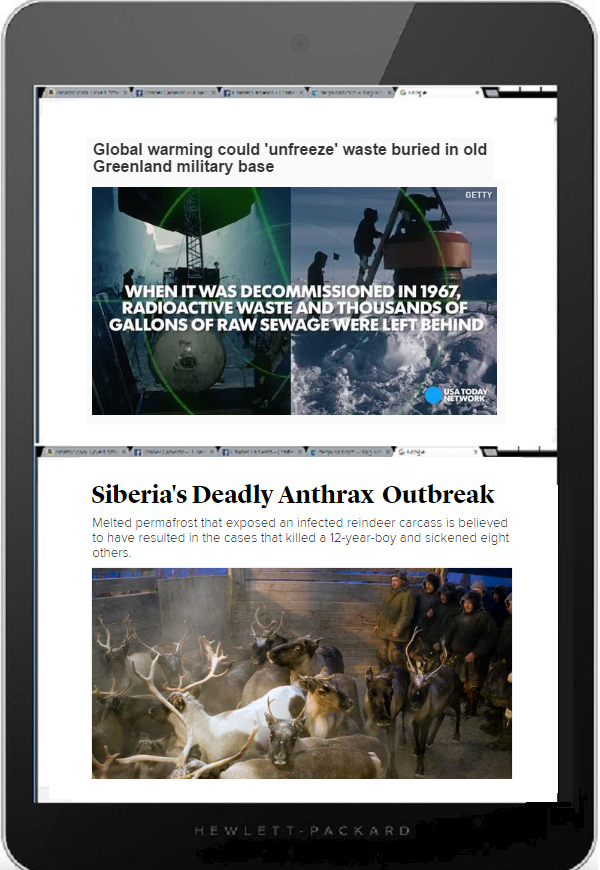The great northern thaw
[ by Charles Cameron — okay, methane, yes, for starters — now add some radioactive waste and anthrax to the brew ]
.
Two recent items that caught my eye:
Sources:
USA Today, Global warming could ‘unfreeze’ waste buried in old Greenland military base The Atlantic, Siberia’s Deadly Anthrax Outbreak
**
More generally, we non-expert interested folk have known for a while — assuming, say, we read the New York Times piece, As Permafrost Thaws, Scientists Study the Risks, back in 2011 — that loss of permafrost was hazardous to planetary health:
Experts have long known that northern lands were a storehouse of frozen carbon, locked up in the form of leaves, roots and other organic matter trapped in icy soil — a mix that, when thawed, can produce methane and carbon dioxide, gases that trap heat and warm the planet. But they have been stunned in recent years to realize just how much organic debris is there.
A recent estimate suggests that the perennially frozen ground known as permafrost, which underlies nearly a quarter of the Northern Hemisphere, contains twice as much carbon as the entire atmosphere.
Temperatures are warming across much of that region, primarily, scientists believe, because of the rapid human release of greenhouse gases. Permafrost is warming, too. Some has already thawed, and other signs are emerging that the frozen carbon may be becoming unstable. [ .. ]
If a substantial amount of the carbon should enter the atmosphere, it would intensify the planetary warming. An especially worrisome possibility is that a significant proportion will emerge not as carbon dioxide, the gas that usually forms when organic material breaks down, but as methane, produced when the breakdown occurs in lakes or wetlands. Methane is especially potent at trapping the sun’s heat, and the potential for large new methane emissions in the Arctic is one of the biggest wild cards in climate science.
**
Okay, now we can also think about rotting reindeer carcases and radioactive waste.
I can’t see Russia from my house, but it looks as though the Russians have the reindeer anthrax issue well in hand, and the “once top-secret subterranean U.S. nuclear base in northern Greenland” with its “radioactive coolant, PCBs, and raw sewage that the military originally believed would stay entombed for millennia” seems to pale in comparison with the possibilities of methane discharge — Cheryl Rofer could no doubt estimate the comparative risks far better than I — so this post is not intended as a scare-alert, but as yet another example of a category that interests me way more than most — which is why I’d like to direct it:
Attn: Department of Blindspots and Unintended Consequences
.




August 9th, 2016 at 6:58 pm
“Radioactive waste” is always good for a scare headline. As far as I can tell from what I’ve read, the radwaste is the smallest part of the problem. There seem to be a lot of chlorinated hydrocarbons, which would seem to be the biggest problem. The radwaste seems to be lightly contaminated wipes and equipment, no big deal. And sewage is biodegradeable. But this stuff is usually reported poorly, so I could be wrong.
.
The more reliable reports I’ve read about Camp Century say that melting in the area of the wastes may start in seventy-five years. We might think about turning global warming around by then, but I could be wrong there too.
August 9th, 2016 at 7:35 pm
Thanks, Cheryl. Would you agree that b0th issues — the rainderr and the bae — pale in comparison with the methane issue? I have the impression the other two are minor though interesting, but that one is way more significant in real world implications..
August 9th, 2016 at 8:03 pm
Yes – ulitmately it’s global warming that’s the problem, and the methane will add to that, although it won’t stick around as long as the carbon dioxide. But it would add to warming already in progress. And that’s not even talking about the methane hydrates in the oceans…